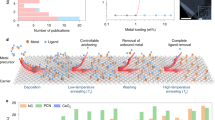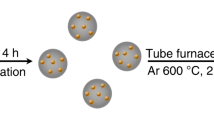Abstract
Atomically dispersed single-atom catalysts have the potential to bridge heterogeneous and homogeneous catalysis. Dozens of single-atom catalysts have been developed, and they exhibit notable catalytic activity and selectivity that are not achievable on metal surfaces. Although promising, there is limited knowledge about the boundaries for the monometallic single-atom phase space, not to mention multimetallic phase spaces. Here, single-atom catalysts based on 37 monometallic elements are synthesized using a dissolution-and-carbonization method, characterized and analysed to build the largest reported library of single-atom catalysts. In conjunction with in situ studies, we uncover unified principles on the oxidation state, coordination number, bond length, coordination element and metal loading of single atoms to guide the design of single-atom catalysts with atomically dispersed atoms anchored on N-doped carbon. We utilize the library to open up complex multimetallic phase spaces for single-atom catalysts and demonstrate that there is no fundamental limit on using single-atom anchor sites as structural units to assemble concentration-complex single-atom catalyst materials with up to 12 different elements. Our work offers a single-atom library spanning from monometallic to concentration-complex multimetallic materials for the rational design of single-atom catalysts.
This is a preview of subscription content, access via your institution
Access options
Access Nature and 54 other Nature Portfolio journals
Get Nature+, our best-value online-access subscription
$29.99 / 30 days
cancel any time
Subscribe to this journal
Receive 12 print issues and online access
$259.00 per year
only $21.58 per issue
Buy this article
- Purchase on Springer Link
- Instant access to full article PDF
Prices may be subject to local taxes which are calculated during checkout




Similar content being viewed by others
Data availability
The data that support the findings of this study are available within the paper and its Supplementary Information. Source data are provided with this paper. Any other data are available from the corresponding author on request.
References
Wu, G., More, K. L., Johnston, C. M. & Zelenay, P. High-performance electrocatalysts for oxygen reduction derived from polyaniline, iron, and cobalt. Science 332, 443–447 (2011).
Qiao, B. et al. Single-atom catalysis of CO oxidation using Pt1/FeOx. Nat. Chem. 3, 634–641 (2011).
Cui, X., Li, W., Ryabchuk, P., Junge, K. & Beller, M. Bridging homogeneous and heterogeneous catalysis by heterogeneous single-metal-site catalysts. Nat. Catal. 1, 385–397 (2018).
Ji, S., Chen, Y., Zhang, Z., Wang, D. & Li, Y. Chemical synthesis of single atomic site catalysts. Chem. Rev. 120, 11900–11955 (2020).
Xiong, Y. et al. Single-atom Rh/N-doped carbon electrocatalyst for formic acid oxidation. Nat. Nanotechnol. 15, 390–397 (2020).
Wang, Y. et al. Advanced electrocatalysts with single-metal-atom active sites. Chem. Rev. 120, 12217–12314 (2020).
Jiang, K. et al. Dynamic active-site generation of atomic iridium stabilized on nanoporous metal phosphides for water oxidation. Nat. Commun. 11, 2701 (2020).
Han, L. et al. Atomically dispersed molybdenum catalysts for efficient ambient nitrogen fixation. Angew. Chem. Int. Ed. 58, 2321–2325 (2019).
Han, L. et al. Stable and efficient single-atom Zn catalyst for CO2 reduction to CH4. J. Am. Chem. Soc. 142, 12563–12567 (2020).
Han, L. et al. Local modulation of single-atomic Mn sites for enhanced ambient ammonia electrosynthesis. ACS Catal. 11, 509–516 (2020).
Zhao, L. et al. Cascade anchoring strategy for general mass production of high-loading single-atomic metal–nitrogen catalysts. Nat. Commun. 10, 1278 (2019).
Gu, J., Hsu, C.-S., Bai, L., Chen, H. M. & Hu, X. Atomically dispersed Fe3+ sites catalyze efficient CO2 electroreduction to CO2. Science 364, 1091–1094 (2019).
Fei, H. et al. General synthesis and definitive structural identification of MN4C4 single-atom catalysts with tunable electrocatalytic activities. Nat. Catal. 1, 63–72 (2018).
Gao, C. et al. Heterogeneous single-atom photocatalysts: fundamentals and applications. Chem. Rev. 120, 12175–12216 (2020).
Ding, S. P., Hulsey, M. J., Perez-Ramirez, J. & Yang, N. Transforming energy with single-atom catalysts. Joule 3, 2897–2929 (2019).
Fei, H. et al. Single atom electrocatalysts supported on graphene or graphene-like carbons. Chem. Soc. Rev. 48, 5207–5241 (2019).
Yang, H. et al. A universal ligand mediated method for large scale synthesis of transition metal single atom catalysts. Nat. Commun. 10, 4585 (2019).
Wang, L. et al. A sulfur-tethering synthesis strategy toward high-loading atomically dispersed noble metal catalysts. Sci. Adv. 5, eaax6322 (2019).
Jones, J. et al. Thermally stable single-atom platinum-on-ceria catalysts via atom trapping. Science 353, 150–154 (2016).
Guo, J. et al. Nitrogen-doped porous carbon supported nonprecious metal single-atom electrocatalysts: from synthesis to application. Small Methods 3, 1900159 (2019).
Vukmirovic, M. B., Teeluck, K. M., Liu, P. & Adzic, R. R. Single platinum atoms electrocatalysts: oxygen reduction and hydrogen oxidation reactions. Croat. Chem. Acta 90, 225–230 (2017).
Asakura, D. et al. Material/element-dependent fluorescence-yield modes on soft X-ray absorption spectroscopy of cathode materials for Li-ion batteries. AIP Adv. 6, 035105 (2016).
Shannon, R. D. Revised effective ionic radii and systematic studies of interatomic distances in halides and chalcogenides. Acta Crystallogr. 32, 751–767 (1976).
Walsh, A., Sokol, A. A., Buckeridge, J., Scanlon, D. O. & Catlow, C. R. A. Oxidation states and ionicity. Nat. Mater. 17, 958–964 (2018).
Wang, J. et al. Design of N-coordinated dual-metal sites: a stable and active Pt-free catalyst for acidic oxygen reduction reaction. J. Am. Chem. Soc. 139, 17281–17284 (2017).
Ren, W. et al. Isolated diatomic Ni–Fe metal–nitrogen sites for synergistic electroreduction of CO2. Angew. Chem. Int. Ed. 58, 6972–6976 (2019).
Gu, J., Hsu, C.-S., Bai, L., Chen, H. M. & Hu, X. Atomically dispersed Fe3+ sites catalyze efficient CO2 electroreduction to CO. Science 364, 1091–1094 (2019).
Luo, X., Jean-Charles, R. & Yu, S. Effect of temperature on graphite oxidation behavior. Nucl. Eng. Des. 227, 273–280 (2004).
Zhang, B. et al. Homogeneously dispersed multimetal oxygen-evolving catalysts. Science 352, 333–337 (2016).
Qiu, H.-J. et al. Noble metal-free nanoporous high-entropy alloys as highly efficient electrocatalysts for oxygen evolution reaction. ACS Mater. Lett. 1, 526–533 (2019).
Ding, Z. et al. High entropy intermetallic–oxide core–shell nanostructure as superb oxygen evolution reaction catalyst. Adv. Sustain. Syst. 4, 1900105 (2020).
Fang, G. et al. Multi-component nanoporous alloy/(oxy)hydroxide for bifunctional oxygen electrocatalysis and rechargeable Zn–air batteries. Appl. Catal. B 268, 118431 (2020).
Sun, H. et al. Atomic metal–support interaction enables reconstruction-free dual-site electrocatalyst. J. Am. Chem. Soc. 144, 1174–1186 (2022).
Mkhoyan, K. A., Batson, P. E., Cha, J., Schaff, W. J. & Silcox, J. Direct determination of local lattice polarity in crystals. Science 312, 1354–1354 (2006).
Ravel, B. & Newville, M. ATHENA, ARTEMIS, HEPHAESTUS: data analysis for X-ray absorption spectroscopy using IFEFFIT. J. Synchrotron Radiat. 12, 537–541 (2005).
Joly, Y. X-ray absorption near-edge structure calculations beyond the muffin-tin approximation. Phys. Rev. B 63, 125120 (2001).
Bunău, O. & Joly, Y. Self-consistent aspects of x-ray absorption calculations. J. Phys. Condens. Matter 21, 345501 (2009).
Kresse, G. & Hafner, J. Ab initio molecular-dynamics simulation of the liquid-metal–amorphous-semiconductor transition in germanium. Phys. Rev. B 49, 14251–14269 (1994).
Kresse, G. & Furthmüller, J. Efficiency of ab initio total energy calculations for metals and semiconductors using a plane-wave basis set. Comput. Mater. Sci. 6, 15–50 (1996).
Perdew, J. P., Burke, K. & Ernzerhof, M. Generalized gradient approximation made simple. Phys. Rev. Lett. 77, 3865–3868 (1996).
Payne, M. C., Teter, M. P., Allan, D. C., Arias, T. A. & Joannopoulos, J. D. Iterative minimization techniques for ab initio total-energy calculations: molecular dynamics and conjugate gradients. Rev. Mod. Phys. 64, 1045–1097 (1992).
Kirklin, S. et al. The Open Quantum Materials Database (OQMD): assessing the accuracy of DFT formation energies. NPJ Comput. Mater. 1, 15010 (2015).
Acknowledgements
This work was supported by the National Science Foundation under award number CHE-1900401 and the start-up funding of H.L.X provided by UC Irvine. This research used resources of the Center for Functional Nanomaterials as well as 7-BM and 23-ID-2 beamlines of the National Synchrotron Light Source II, which are two US Department of Energy (DOE) Office of Science User Facilities operated for the DOE Office of Science by Brookhaven National Laboratory under contract DE-SC0012704. It also used resources of the Advanced Photon Source, a US DOE Office of Science User Facility operated for the DOE Office of Science by Argonne National Laboratory under contract DE-AC02-06CH11357. The XAFS/EXAFS spectra obtained from beamline TPS 44A at the National Synchrotron Radiation Research Center (NSRRC) and the soft XAS data obtained from beamline TLS-BL24A at NSRRC are appreciated. This work made use of facilities and instrumentation at the UC Irvine Materials Research Institute (IMRI), which is supported in part by the National Science Foundation through the UC Irvine Materials Research Science and Engineering Center (DMR-2011967). W.L., H.L., J.L. and J.-C.Z. are unfunded.
Author information
Authors and Affiliations
Contributions
H.L.X. conceived the idea. J.L., J.-C.Z. and H.L.X. co-supervised the project and revised the paper. L.H. designed the experiments and wrote the paper. H.C. performed the XANES and EXAFS fittings and analyses. W.L. and H.L. synthesized the samples. P.O. performed the DFT calculations of formation energy. L.H., R.L., H.-T.W., C.-W.P., C.-J.S., C.H.W. and W.-F.P. took and analysed the soft XAS and XAFS spectra. L.H., A.R.H. and X.T. performed the in situ XPS experiments. All authors discussed the results and implications at all stages.
Corresponding authors
Ethics declarations
Competing interests
The authors declare no competing interests.
Peer review
Peer review information
Nature Materials thanks Taeghwan Hyeon and the other, anonymous, reviewer(s) for their contribution to the peer review of this work.
Additional information
Publisher’s note Springer Nature remains neutral with regard to jurisdictional claims in published maps and institutional affiliations.
Supplementary information
Supplementary Information
Supplementary Figs. 1–71, Tables 1–9 and refs. 1–16.
Supplementary Data
Optimized computational models.
Source data
Source Data Fig. 1
Source Data for Fig. 1d.
Source Data Fig. 2
Source Data for Fig. 2.
Source Data Fig. 3
Source Data for Fig. 3a,c,f–l.
Source Data Fig. 4
Source Data for Fig. 4e–h.
Rights and permissions
About this article
Cite this article
Han, L., Cheng, H., Liu, W. et al. A single-atom library for guided monometallic and concentration-complex multimetallic designs. Nat. Mater. 21, 681–688 (2022). https://doi.org/10.1038/s41563-022-01252-y
Received:
Accepted:
Published:
Issue Date:
DOI: https://doi.org/10.1038/s41563-022-01252-y
This article is cited by
-
Photo-induced synthesis of heteronuclear dual-atom catalysts
Nature Synthesis (2024)
-
Nanocurvature-induced field effects enable control over the activity of single-atom electrocatalysts
Nature Communications (2024)
-
Recent progress of Pt-based oxygen reduction reaction catalysts for proton exchange membrane fuel cells
Rare Metals (2024)
-
Advances of machine learning in materials science: Ideas and techniques
Frontiers of Physics (2024)
-
Enhancing alkyne semi-hydrogenation through engineering metal-support interactions of Pd on oxides
Nano Research (2024)



